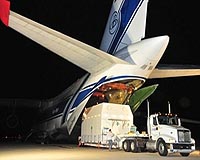 |
Seoul, South Korea (Yonhap) Aug 17, 2009 Bad weather conditions could pose a final hurdle to the timely launch of South Korea's first space rocket, experts said Sunday. Local rocket experts said while technicians and engineers will check all mechanical and operational systems related to the launch, inclement weather could postpone or endanger the safety of the Korea Space Launch Vehicle-1 (KSLV-1) that is scheduled to blast off from Naro Space Center on Wednesday. "Everything humanly possible will be done to make the launch a success but there will always be unknown factors that could cause problems," Lee Joo-jin, head of the Korea Aerospace Research Institute (KARI), said. He said strong winds and lightening could cause mission control to delay a launch, with the latter being a source of concern. Working level engineers at state-run KARI, which is managing the launch, said there will be a multi-tiered monitoring system to check even small changes in weather conditions. Daily and long-term forecasts will be checked by the Korea Meteorological Administration and the military, with regional conditions being monitored by a weather radar and sensors at the Naro center on Oenarodo Island, off South Korea's southern coast. "Unless there is torrential rain, the launch should not be affected but keeping close tabs on the weather is important, especially after the kerosene fuel and oxidation materials have been injected into the rocket," an engineer said. He stressed that should the weather cause the launch to be aborted, the fuel and oxidation materials could be emptied speedily as engineers have trained for such an occasion, but under such conditions the launch will have to be pushed back 24 hours. Under existing operating procedures, the countdown of the KSLV-1 could be delayed if lightning is detected within 20km of the launch area and in the trajectory of the rocket's flight path. A lightning strike hitting the rocket can cause mechanical failure, though there may be no way to guard against lightning strikes once the rocket climbs high into the atmosphere as they cannot be detected or predicted at these altitudes. High wind can also force a rescheduling if the average wind speed surpasses 21 meters per second. Such conditions can affect the stability of the rocket as it soars into the sky. Flight controllers will, in addition, be looking to check wind speeds higher up in the atmosphere that exceed 100 meters per second, which can force the rocket to veer off its intended course. KARI, meanwhile, said that because the KSLV-1 draws its power from on-board solar panels, the time of the launch has been set to maximize exposure to the sun. At present, the satellite-bearing rocket is expected to be launched at 4:40 p.m. (Seoul Time), though this can be put off until 6:20 p.m. If the satellite is launched on time, it can reach orbit and deploy its panels while there is plenty of sunlight.
Source: Yonhap Share This Article With Planet Earth
Related Links Korea Aerospace Research Institute (KARI) Launch Pad at Space-Travel.com
 ILS Proton Successfully Launches AsiaSat 5 Satellite
ILS Proton Successfully Launches AsiaSat 5 SatelliteBaikonur, Kazakhstan (SPX) Aug 13, 2009 International Launch Services (ILS), a world leader in providing mission and launch services to the commercial satellite industry, successfully carried the AsiaSat 5 satellite into orbit on an ILS Proton for Asia Satellite Telecommunications Company Limited (AsiaSat) of Hong Kong. This was the fourth commercial mission of the year for ILS and the sixth successful Proton launch of 2009. From cont ... read more |
|
| The content herein, unless otherwise known to be public domain, are Copyright 1995-2009 - SpaceDaily. AFP and UPI Wire Stories are copyright Agence France-Presse and United Press International. ESA Portal Reports are copyright European Space Agency. All NASA sourced material is public domain. Additional copyrights may apply in whole or part to other bona fide parties. Advertising does not imply endorsement,agreement or approval of any opinions, statements or information provided by SpaceDaily on any Web page published or hosted by SpaceDaily. Privacy Statement |